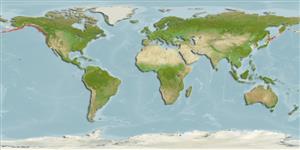>
Perciformes/Zoarcoidei (Eelpouts and pricklebacks) >
Stichaeidae (Pricklebacks) > Xiphisterinae
Etymology: Anoplarchus: Greek, ana = up + Greek, oplon = shield + Greek, archos = anus (Ref. 45335).
More on author: Gill.
Environment: milieu / climate zone / depth range / distribution range
экология
морской демерсальный; пределы глубины 1 - 30 m (Ref. 2850). Temperate; 66°N - 32°N
Eastern Pacific: Pribilof Islands, Alaska to Santa Rosa Island and Trinidad Bay, southern California, USA.
Size / Вес / Возраст
Maturity: Lm ? range ? - ? cm
Max length : 20.0 cm TL самец/пол неопределен; (Ref. 2850)
Краткое описание
морфология | морфометрия
колючие лучи спинного плавника (общее число): 55 - 58; членистые (мягкие) лучи спинного плавника (общее число): 0; колючие лучи анального плавника 0; членистые (мягкие) лучи анального плавника: 39 - 40; позвонки: 58 - 61. Caudal with convex outer margin (Ref. 6885). Color very variable- may be light to dark gray with olivaceous overtones, brown to dark brown with or without reddish overtones, or purple to almost black. Females are less varied in color, but show more pattern, usually having green grayish backgrounds with brownish reticulations, or dark brownish backgrounds with subdued reticulation. Belly pale. In the males, the cockscomb and under surface of head are pale, rather yellowish, and without speckling. In the female, the head is more speckled and mottled. There is a gray bar across the base of the caudal peduncle. At breeding season, the male develops bright orange colors on its anal and pectoral fins, and reddish on the caudal and dorsal fins (Ref. 6885).
Facultative air-breathing (Ref. 126274); Usually found in intertidal areas under rocks (Ref. 2850). May remain out of water under rocks or seaweed (Ref. 31184). Green algae is an important food item but may also feed on polychaete worms, crustaceans and mollusks (Ref. 6885). Breathes air (Ref. 31184) and can remain out of water for 15-25 hours if kept moist (Ref. 51276).
Spawning individuals are territorial. The female guards the egg mass deposited between rocks and shells by bending her body over the eggs. She fans the eggs by moving the posterior part of her body (Ref. 6885). In the aquarium, males mate with several females (Ref. 39998).
Eschmeyer, W.N., E.S. Herald and H. Hammann, 1983. A field guide to Pacific coast fishes of North America. Boston (MA, USA): Houghton Mifflin Company. xii+336 p. (Ref. 2850)
Статус Красного Списка МСОП (Ref. 130435)
Угроза для людей
Harmless
Использование человеком
дополнительная информация
Возраст/РазмерыростЗависимость между длиной и массой телаЗависимость между длинамиРазмерный составморфометрияморфологияличинкидинамика численности личинокпополнениечисленностьBRUVS
ссылкиаквакультура (рыбоводство)особенности рыбоводствастепень растяжениягенетикаElectrophoresesнаследуемостьболезниобработкаNutrientsMass conversion
соавторыизображенияStamps, Coins Misc.звукиCiguateraскоростьтип плаванияжаберная областьOtolithsмозгзрение
инструменты
Специальные отчеты
Скачать в формате XML
ресурсы в Интернет
Estimates based on models
Preferred temperature (Ref.
123201): 5.9 - 13.4, mean 8.9 °C (based on 428 cells).
Phylogenetic diversity index (Ref.
82804): PD
50 = 0.7500 [Uniqueness, from 0.5 = low to 2.0 = high].
Bayesian length-weight: a=0.00389 (0.00180 - 0.00842), b=3.12 (2.94 - 3.30), in cm total length, based on all LWR estimates for this body shape (Ref.
93245).
Trophic level (Ref.
69278): 2.9 ±0.1 se; based on diet studies.
устойчивость к внешним воздействиям (Ref.
120179): средний (среднего размера), минимальное время удвоения популяции 1.4-4.4 года (tm=2-3; Fec=2,700).
Fishing Vulnerability (Ref.
59153): Low vulnerability (10 of 100).
